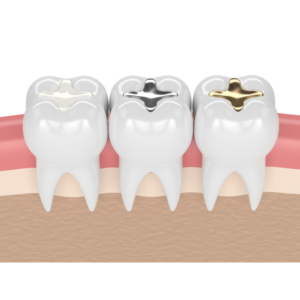White or Silver?

teeth with gold, amalgam and composite fillings
One controversy in dentistry over the last decade deals with the choice of using an amalgam (silver) or a white filling for cavities. Over the past few years, the popularity of white filling materials have increased tremendously. The white filling material is tooth colored so it blends in with your tooth and it can also be used for cosmetic improvements (Usually called cosmetic bonding) of the smile by changing the color of the teeth or reshaping disfigured teeth. Composites bond to the tooth to support the remaining tooth structure, which helps to prevent breakage and insulate the tooth from excessive temperature changes.
The dental amalgam (‘silver’) filling material has been used for 150 years and has a good track record. But there has been a controversy dealing with the safety of the filling material. Dental amalgam is a mixture of mercury, silver, tin and copper. Mercury, which makes up about 50 percent of the compound, is used to bind the metals together and to provide a strong, hard, durable filling. While extremely toxic, when the mercury is combined with other materials in dental amalgam, its chemical nature changes so it can’t be released into your mouth in significant amounts. While the FDA maintains that amalgam fillings are within current safety limits, there is still a major controversy about the safety of the toxic metals used to make up the amalgam. A few years ago, the FDA upgraded them from low risk to a moderate risk treatment due to published research on the health effects of mercury in our fillings. At Smile Sarasota, we take a conservative approach to amalgam removal. If the mercury-silver amalgam filling is decayed or compromised, we will replace it with a composite resin filling. We have not used amalgam at Smile Sarasota for many years. We dispose of the removed amalgam filling in our amalgam separator to prevent the mercury from entering Sarasota’s sewage and water-supply.
Composite resin fillings are the most popular type of filling used in a modern dental practice. They are tooth-colored fillings that replicate the natural appearance of healthy enamel, making them a more life-like cavity treatment. They form a chemical bond with the tooth for a more reliable fit. They don’t have the same risks as mercury-silver amalgam fillings and are more attractive than metal fillings. Because composite resin fillings are so versatile, we recommend them for most types of cavities.
What are the advantages of composites? Aesthetics is the main advantage, since we can blend shades to create a color nearly identical to that of the actual tooth. Composites bond to the tooth to support the remaining tooth structure, which helps to prevent breakage and insulate the tooth from excessive temperature changes. Composites often allow usto prepare a cavity much smaller than can be achieved with gold, porcelain or silver amalgam fillings. Making a smaller filling is very important to the strength of a tooth and for increasing the amount of time a filling will wear. Composites work very well with laser prepared cavities. Composite bonding on the front teeth can be made very beautiful and natural looking. Composites can be used to seal a tooth in young people to prevent the most common pit and fissure decay. Composites can many times be repaired instead of having to remove the whole filling if part of it has failed.
What are the disadvantages? Composites are technique sensitive and intolerant of any moisture when being placed. It is sometimes impossible to keep a cavity dry to place a composite. Also, the shade of the composite can change slightly if the patient drinks tea, coffee or other staining foods. Composites tend to wear out sooner than silver fillings in larger cavities, although they hold up as well in small cavities.
How long will a composite last? Studies have shown that composites last 7-10 years, which is comparable to silver fillings except in very large restorations, where silver fillings last longer than composites. We now believe there is no advantage, (and indeed there is a distinct disadvantage), in using dental silver amalgam for reasons of durability.
Why has Smile Sarasota elected not to use dental amalgam? Smile Sarasota has considered all information very carefully and we have concluded that with the advances of composite restoration and now the addition of CEREC in office porcelain restorations that there is no need for us to use dental amalgams in our dental practice. If you have any questions about the best procedures for you, call us today to set up a consultation and Dr. Still will be happy to answer your questions!
Sources and Credits: American Dental Association, Federal Drug Administration, WebMD, Academy of General Dentistry



